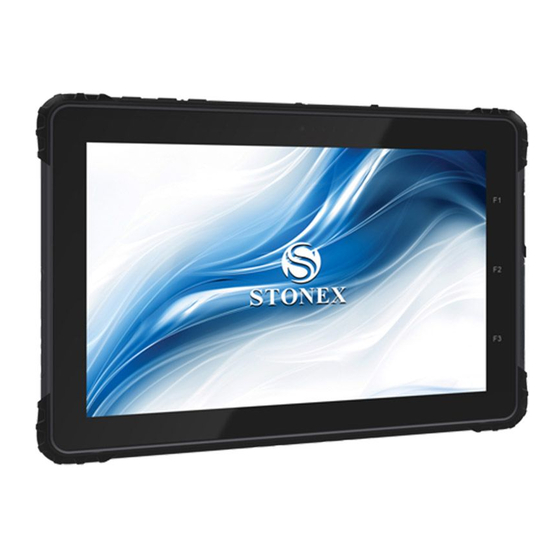
Advertisement
Quick Links
Advertisement

Summary of Contents for UniStrong UT56
- Page 1 UT56 Quick Start Guide...
-
Page 2: Function Introduction
Function introduction Power volume Nano SIM Micro SD Camera LED Light Sensor Front Camera Charging LED 3.5mm Headset Type-c Kensington Lock Hang rope hole Docking Contact Pins... - Page 3 LED flash Rear camera Speaker Air vent...
- Page 4 INSERT/REMOVE SD/SIM Install or remove SD card as shown below Micro SD...
- Page 5 Notice 1. Some special places, such as airports, hospitals, gas stations and other places, do not allow the use of electronic equipment. Please comply with the rules and do not use this product in these places. 2. For your safety and the safety of others, please do not use this product while driving a vehicle.
- Page 6 Shenzhen City, Guangdong Province, P.R. China NOTICE: The SAR limit of Europe is 2.0 W/kg. Device types UT56 has also been tested against this SAR limit. The highest SAR value reported under this standard during product certification when properly worn on the body is 0.534W/kg This device was tested for typical body - worn operations with the back of the handset kept 0 cm from the body.
- Page 7 Hereby, [Shenzhen UniStrong Science & Technology Co.,Ltd.] declares that the radio equipment type [UT56] is in compliance with Directive 2014 / 53 /EU. The full text of the EU declaration of conformity is available at the following internet address: http:en.unistrong.com/declaration.html...
- Page 8 NOTICE: The SAR limit of FCC and ISED is 1.6 W/kg averaged over one gram of tissue. Device types UT56 ( FCC ID:2AOPD-UT56 and IC: 11546A-UT56 ) has also been tested against this SAR limit. The highest SAR value reported under this standard during product certification for use on the body is 1.041 W/kg.
- Page 9 NOTICE: This device complies with Part 15 of the FCC Rules and with RSS-210 of Industry Canada. Operation is subject to the following two conditions: (1) this device may not cause harmful interference, and (2) this device must accept any interference received, including interference that may cause undesired operation.
- Page 10 www.UniStrong.com...
- Page 11 Normal Mode RF Power Range (GSM, WCDMA) Mode Range(dBm) GPRS900 (1 Slot) 30.50-31.50 GPRS900 (2 Slots) 30.50-31.50 GPRS900 (3 Slots) 30.50-31.50 GPRS900 (4 Slots) 30.50-31.50 EGPRS (8PSK, 1-Slot) 22.00-22.50 EGPRS (8PSK, 2-Slots) 22.00-22.50 EGPRS (8PSK, 3-Slots) 22.00-22.50 EGPRS (8PSK, 4-Slots) 22.00-22.50 GPRS1800 (1 Slot) 26.00-27.00...
- Page 12 Normal Mode RF Power Range (LTE) Bandwidth Mode Modulation Range(dBm) 23.00-24.00 QPSK 22.00-22.50 22.00-22.50 20 MHz 22.00-23.00 16QAM 21.00-21.50 21.00-21.50 23.00-23.50 QPSK 22.00-22.50 22.00-22.50 15 MHz 22.00-23.00 16QAM 21.00-21.50 21.00-21.50 LTE Band 1 23.00-23.50 QPSK 22.00-22.50 22.00-22.50 10 MHz 22.00-23.00 16QAM 21.00-21.50 21.00-21.50...
- Page 13 22.00-23.00 24.00-25.00 QPSK 23.00-24.00 23.00-24.00 15 MHz 23.00-24.00 16QAM 22.00-23.00 22.00-23.00 24.00-25.00 QPSK 23.00-24.00 23.00-24.00 10 MHz 23.00-24.10 16QAM 22.00-23.00 22.00-23.00 24.00-25.00 QPSK 23.00-24.00 23.00-24.00 5 MHz 23.00-24.10 16QAM 22.00-23.00 22.00-23.00 24.00-25.00 QPSK 23.00-24.00 23.00-24.00 3 MHz 23.00-24.00 16QAM 22.00-23.00 22.00-23.00 24.00-25.00 QPSK...
- Page 14 Bandwidth Mode Modulation Range(dBm) 23.00-24.50 QPSK 22.00-23.00 22.00-23.00 20 MHz 22.50-23.50 16QAM 21.00-22.00 21.00-22.00 23.00-24.00 QPSK 22.00-23.00 22.00-23.00 15 MHz 22.00-23.00 16QAM 21.00-22.00 21.00-22.00 LTE Band 7 23.00-24.00 QPSK 22.00-23.00 22.00-23.00 10 MHz 22.00-23.00 16QAM 21.00-22.00 21.00-22.00 23.00-24.00 QPSK 22.00-23.00 22.00-23.00 5 MHz 22.00-23.10...
- Page 15 22.00-23.00 22.00-23.00 22.00-23.00 16QAM 21.00-22.00 21.00-22.00 23.00-24.00 QPSK 22.00-23.00 22.00-23.00 3 MHz 22.00-23.00 16QAM 21.00-22.00 21.00-22.00 23.00-24.00 QPSK 22.00-23.00 22.00-23.00 1.4 MHz 22.00-23.00 16QAM 21.00-22.00 21.00-22.00 Bandwidth Mode Modulation Range(dBm) 24.00-25.00 QPSK 23.00-24.00 23.00-24.00 20 MHz 23.50-24.50 16QAM 22.00-23.00 22.00-23.00 24.00-25.00 LTE Band 20 QPSK...
- Page 16 23.00-24.00 16QAM 22.00-23.00 22.00-23.00 24.00-25.00 QPSK 23.00-24.00 23.00-24.00 5 MHz 23.00-24.10 16QAM 22.00-23.00 22.00-23.00 Bandwidth Mode Modulation Range(dBm) 23.00-24.00 QPSK 22.00-23.00 22.00-23.00 20 MHz 22.00-23.00 16QAM 21.00-22.00 21.00-22.00 23.00-24.00 QPSK 22.00-23.00 22.00-23.00 15 MHz 22.00-23.00 16QAM 21.00-22.00 LTE Band 28 21.00-22.00 23.00-24.00 QPSK...
- Page 17 21.00-22.00 23.00-24.00 QPSK 22.00-23.00 22.00-23.00 3 MHz 22.00-23.00 16QAM 21.00-22.00 21.00-22.00 Bandwidth Mode Modulation Range(dBm) 22.50-23.50 QPSK 21.50-22.50 21.50-22.50 20 MHz 22.00-23.00 16QAM 20.50-21.50 20.50-21.50 22.50-23.50 QPSK 21.50-22.50 21.50-22.50 15 MHz 22.00-23.00 16QAM 20.50-21.50 20.50-21.50 LTE Band 38 22.50-23.50 QPSK 21.50-22.50 21.50-22.50 10 MHz...
- Page 18 Bandwidth Mode Modulation Range(dBm) 24.00-25.00 QPSK 23.00-24.00 23.00-24.00 20 MHz 23.50-24.00 16QAM 22.00-23.00 22.00-23.00 24.00-25.00 QPSK 23.00-24.00 23.00-24.00 15 MHz 23.50-24.10 16QAM 22.00-23.00 22.00-23.00 LTE Band 40 24.00-25.00 QPSK 23.00-24.00 23.00-24.00 10 MHz 23.50-24.20 16QAM 22.00-23.00 22.00-23.00 24.00-25.00 QPSK 23.00-24.00 23.00-24.00 5 MHz 23.50-24.00...
- Page 19 Normal Mode RF Power Range (WLAN/Bluetooth) Band (GHz) Mode Range(dBm) 802.11b 11.50-12.50 802.11g 10.00-11.50 WIFI 2.4G (2.4~2.4835) 802.11n(HT20) 10.00-11.50 802.11n(HT40) 10.00-11.70 Band (GHz) Mode Range(dBm) 802.11a 10.00-11.00 802.11n(HT20) 10.50-11.50 802.11ac(VHT20) 10.00-11.00 WIFI 5.2 G (5.15~5.25) 802.11n(HT40) 10.00-10.70 802.11ac(VHT40) 10.00-10.70 802.11ac(VHT80) 10.00-10.60 802.11a 10.00-11.00...


Need help?
Do you have a question about the UT56 and is the answer not in the manual?
Questions and answers